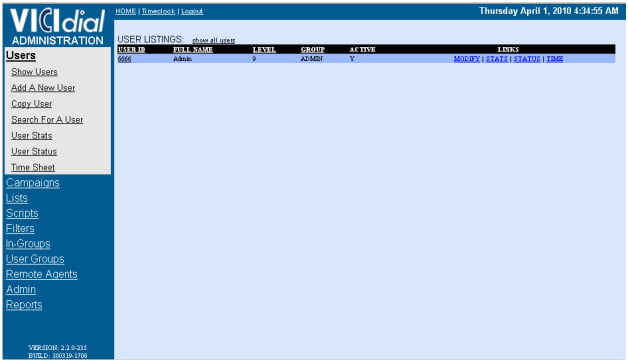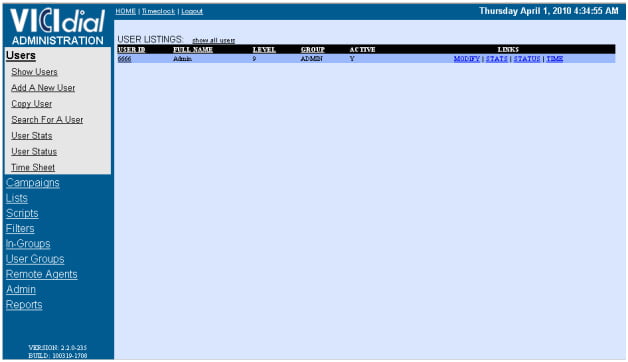Here we are presenting the Step by step tutorial to install VICIdial.
VICIdial is a Software (group of scripts/programs) that is created or developed in order to interact with Astrisk Open Source IP PBX Phone System to enable it to function as an inbound / outbound call center solution with inbound email support. Scripts are written in PERL and PHP and uses MySQL as its database server, Apache / Httpd Server for its front end web interface and Linux as its operating system.
VICIdial is open source and has been developed by vicidial group lead by Matt Florel.

VICIdial is designed to work with an Asterisk System that has /DAHDI(T1/E1/PSTN) telco lines or VOIP(IAX or SIP) trunks and many different kinds of softphones and hardphones. VICIdial is designed to run on any version of Asterisk.
Features of VICIdial
We are presenting here the major features of VICIdial as described at its official website http://www.vicidial.org
- Inbound, Outbound and Blended call handling and Inbound Email handling.
- Outbound agent-controlled, broadcast and predictive dialing.
- Full USA, Canada and UK regulatory compliance capability.
- Web-based agent and administrative interfaces.
- Ability to have agents operate remotely.
- Integrated call recording.
- Three-Way calling within the agent application.
- Scheduled Callbacks: Agent-Only and Anyone.
- Web-configurable IVRs and Voicemail boxes.
- Scalable to hundreds of seats.
- Ability to use standard Telco lines and VOIP trunks.
- Open-Source AGPLv2 licensed, with no software licensing cost.
Now we will be presenting the tutorial to install VICIdial from scratch using:
- Centos 6.5 Operating System
- Asterisk 1.8
- Latest dahdi
- Latest SVN version
Vicidial scratch installation in centos 6.X with Asterisk 1.8, latest Vicidial
Steps Involved in VICIDIAL installation
- Centos 6.X Operating System(OS) installation.
- Dependencies , supporting software and CPAN Modules.
- Asterisk , dahdi , libpri installation.
- Vicidial installation.
Step 1 : Centos 6.X Operating System installation
The Centos 6.X can be download from the following Link
http://wiki.centos.org/Download
Centos 6.X installation steps can be found from following Link
http://www.tecmint.com/centos-6-5-installation-guide-with-screenshots/
You have to Disable Firewall and Selinux before starting the Installations
Stopping the Firewall
iptables -F
service iptables save
Disabling the Selinux
vi /etc/selinux/config
# This file controls the state of SELinux on the system.
# SELINUX= can take one of these three values:
# enforcing – SELinux security policy is enforced.
# permissive – SELinux prints warnings instead of enforcing.
# disabled – SELinux is fully disabled.
SELINUX=disabled
# SELINUXTYPE= type of policy in use. Possible values are:
# targeted – Only targeted network daemons are protected.
# strict – Full SELinux protection.
SELINUXTYPE=targeted # SETLOCALDEFS= Check local definition changes SETLOCALDEFS=0
Step 2 : Dependencies , supporting software and Perl Modules installation
First You have to Update the Operating System (OS) for the latest Kernel and other softwares and then reboot the system
yum –y update
reboot
Dependencies Installation :
yum install make patch gcc gcc-c++ subversion php php-devel php-gd gd-devel php-mbstring php-mcrypt php-imap php-ldap php-mysql php-odbc php-pear php-xml php-xmlrpc curl curl-devel perl-libwww-perl ImageMagick libxml2 libxml2-devel httpd libpcap libpcap-devel libnet ncurses ncurses-devel screen mysql-server mysql-devel ntp kernel* mutt glibc.i686
Setup Mysql
/etc/init.d/mysqld start
mysql_secure_installation
chkconfig mysqld on
service mysqld stop
cp /etc/my.cnf /etc/my.cnf.original
echo “” > /etc/my.cnf
vi /etc/my.cnf; copy the below config to this file.
[mysql.server]
user = mysql
#basedir = /var/lib
[client]
port = 3306
socket = /var/lib/mysql/mysql.sock
[mysqld]
datadir = /var/lib/mysql
#tmpdir = /home/mysql_tmp
socket = /var/lib/mysql/mysql.sock
user = mysql
old_passwords = 0
ft_min_word_len = 3
max_connections = 800
max_allowed_packet = 32M
skip-external-locking
log-error = /var/log/mysqld/mysqld.log
query-cache-type = 1
query-cache-size = 32M
long_query_time = 1
#slow_query_log = 1
#slow_query_log_file = /var/log/mysqld/slow-queries.log
tmp_table_size = 128M
table_cache = 1024
join_buffer_size = 1M
key_buffer = 512M
sort_buffer_size = 6M
read_buffer_size = 4M
read_rnd_buffer_size = 16M
myisam_sort_buffer_size = 64M
max_tmp_tables = 64
thread_cache_size = 8
thread_concurrency = 8
# If using replication, uncomment log-bin below
#log-bin = mysql-bin
[mysqldump]
quick
max_allowed_packet = 16M
[mysql]
no-auto-rehash
[isamchk]
key_buffer = 256M
sort_buffer_size = 256M
read_buffer = 2M
write_buffer = 2M
[myisamchk]
key_buffer = 256M
sort_buffer_size = 256M
read_buffer = 2M
write_buffer = 2M
[mysqlhotcopy]
interactive-timeout
[mysqld_safe]
#log-error = /var/log/mysqld/mysqld.log
#pid-file = /var/run/mysqld/mysqld.pid
mkdir /var/log/mysqld
mv /var/log/mysqld.log /var/log/mysqld/mysqld.log
touch /var/log/mysqld/slow-queries.log
chown -R mysql:mysql /var/log/mysqld
service mysqld restart
Update the Timezone
Configure the system time and update it. Customize the timezone. Take a look inside /usr/share/zoneinfo/ for all possible values.
rm /etc/localtime
ln -sf /usr/share/zoneinfo/Asia/Kolkata /etc/localtime
rdate -s nist1-ny.ustiming.org
Setup CPAN and install libraries
yum install perl-CPAN
yum install perl-YAML
perl -MCPAN -e shell;
just press enter for all the questions.
You will then go through CPAN setup, just hit ENTER for most prompts except for the mirrors list, you will want to select at least 4 mirrors
yes for manual configuration enter for the next 18 prompts
for the “make install” option, it’s a good idea to add UNINST=1
enter for the next 4 prompts
select your continent and country
select a few cpan mirrors
enter for the next 2 prompts
Once you see the cpan> prompt you can begin installing modules.
install CPAN::Meta::Requirements
install CPAN
reload cpan
install YAML
install MD5
install Digest::MD5
install
Digest::SHA1
install readline
install Bundle::CPAN
reload cpan
install DBI
force install DBD::mysql
install Net::Telnet
install Time::HiRes
install Net::Server
install Switch
install Mail::Sendmail
install Unicode::Map
install Jcode
install Spreadsheet::WriteExcel
install OLE::Storage_Lite
install Proc::ProcessTable
install IO::Scalar
install Spreadsheet::ParseExcel
install Curses
install Getopt::Long
install Net::Domain
install Term::ReadKey
install Term::ANSIColor
install Spreadsheet::XLSX
install Spreadsheet::Read
install LWP::UserAgent
install HTML::Entities
install HTML::Strip
install HTML::FormatText
install HTML::TreeBuilder
install Time::Local
install MIME::Decoder
install Mail::POP3Client
install Mail::IMAPClient
install Mail::Message
install IO::Socket::SSL
install MIME::Base64
install MIME::QuotedPrint
install Crypt::Eksblowfish::Bcrypt
quit
In the end run all these commands once again to make sure it’s all installed and make sure you get following output for each module
cpan> install Mail::Message
Mail::Message is up to date (2.115).
cpan> install MIME::QuotedPrint
MIME::QuotedPrint is up to date (3.13).
Installing the Asterisk-Perl module
NOTE: Do NOT use the 0.09 or any newer version, they do not work with ViciDial.
cd /usr/src
wget Download Here
tar -zxf asterisk-perl-0.08.tar.gz
cd asterisk-perl-0.08
perl Makefile.PL
make all
make install
Installing additional software from source
Next, you will download, compile and install the following software.
lame
ttyload
iftop
mtop
mytop
htop
sipsak
ploticus
LAME:
LAME is an MP3 encoder used to convert audio files from WAV to MP3. Some prefer GSM usually, but others have standardized on MP3 so you would need this utility to be loaded to use that option.
cd /usr/src
wget Download Here
tar -zxf lame-3.99.5.tar.gz
cd lame-3.99.5
./configure
make
make install
SOX:
SoX is a cross-platform command line utility that can convert various formats of computer audio files in to other formats.
cd /usr/src
wget Download here
tar -zxf sox-14.4.1.tar.gz
cd sox-14.4.1
./configure
make -s
make install
TTYLOAD:
ttyload is a simple terminal application that shows the processor load in a graphical time-based scrolling graph. I use it to view how loaded the system is and it visualizes load spikes very well.
cd /usr/src
wget – Download Here
tar -xvzf ttyload-0.5.tar.gz
cd ttyload-0.5
nano ttyload.h
insert this #include directive just above the #define directives, then save and close the ttyload.h file
#include
make
ln -s /usr/src/ttyload-0.5/ttyload /usr/bin/ttyload
IFTOP:
iftop is a good console bandwidth visualization tool that shows you active connections, where they are going to/from and how much of your precious bandwidth they are using.
cd /usr/src
wget Download Here
tar -zxf iftop-0.17.tar.gz
cd iftop-0.17
./configure
make
make install
MTOP:
mtop is a great utility for real-time monitoring of mysql and the queries that are running in it.
Note: the root mysql password must be blank before installing this
cd /usr/src
wget Download Here
tar -zxf mtop-0.6.6.tar.gz
cd mtop-0.6.6
perl Makefile.PL
make
make install
MYTOP:
mytop is is an optional utility for monitoring the threads and overall performance of mysql
Note: the root mysql password must be blank before installing this
cd /usr/src
wget Download Here
tar -zxf mytop-1.6.tar.gz
cd mytop-1.6
perl Makefile.PL
make
make test
make install
HTOP:
htop is an interactive process viewer for Linux
cd /usr/src
wget Download Here
tar -zxf htop-1.0.2.tar.gz
cd htop-1.0.2
./configure
make
make install
SIPSAK:
sipsak is an optional utility that VICIDIAL can use to send messages to an agent’s SIP-based phone(like the Snom 320) to display text on their LCD screen.
cd /usr/src
wget Download Here
tar -zxf sipsak-0.9.6-1.tar.gz
cd sipsak-0.9.6
./configure
make
make install
/usr/local/bin/sipsak –version
PLOTICUS:
ploticus is a free graph creation package that allows you to create line graphs within PNG files simply by creating a config file and a data file. ViciDial uses this package to generate server performance graphs that can be displayed real-time within the ViciDial reports page.
cd /usr/src
wget Download Here
tar -zxf ploticus242_src.tar.gz
cd ploticus242/src/
make clean
make
make install
mkdir -p /var/www/html/vicidial/ploticus/
cp pl /var/www/html/vicidial/ploticus/
eAccelerator :
cd /usr/src
wget Download Here
unzip eaccelerator-0.9.6.1.zip
cd eaccelerator-0.9.6.1
export PHP_PREFIX=”/usr”
$PHP_PREFIX/bin/phpize
./configure –enable-eaccelerator=shared –with-php-config=$PHP_PREFIX/bin/php-config
make
make install
Configure php.ini
vi /etc/php.ini
Change the following values in your php.ini file.
Customize the date.timezone so you don’t end up with a bunch of php errors complaining about it not being defined.
error_reporting = E_ALL & ~E_NOTICE
memory_limit = 48M
short_open_tag = On
max_execution_time = 330
max_input_time = 360
post_max_size = 48M
upload_max_filesize = 42M
default_socket_timeout = 360
date.timezone = Asia/Kolkata
Add the following lines to the dynamic extensions section of php.ini:
Note: For CentOS 32-bit, use this
below:zend_extension=”/usr/lib/php/modules/eaccelerator.so”
;Dynamic Extensions
zend_extension=”/usr/lib64/php/modules/eaccelerator.so”
;For CentOS 32-bit: zend_extension=”/usr/lib/php/modules/eaccelerator.so”
eaccelerator.shm_size=”48″
eaccelerator.cache_dir=”/tmp/eaccelerator”
eaccelerator.enable=”1″
eaccelerator.optimizer=”1″
eaccelerator.check_mtime=”1″
eaccelerator.debug=”0″
eaccelerator.filter=””
eaccelerator.shm_max=”0″
eaccelerator.shm_ttl=”0″
eaccelerator.shm_prune_period=”0″
eaccelerator.shm_only=”0″
eaccelerator.compress=”1″
eaccelerator.compress_level=”9″
mkdir /tmp/eaccelerator
chmod 0777 /tmp/eaccelerator
php –v
Editing the Apache config file
vi /etc/httpd/conf/httpd.conf
To disable logging, change:
CustomLog logs/access_log common
to this:
CustomLog /dev/null common
To enable web browsing of Recordings on Asterisk server, add the below line at last line of httpd.conf
Alias /RECORDINGS/ “/var/spool/asterisk/monitorDONE/”
<Directory “/var/spool/asterisk/monitorDONE”>
Options Indexes MultiViews
AllowOverride None
Order allow,deny
Allow from all
Forcetype application/forcedownload
Restart the Apache web server to apply the changes
service httpd restart
chkconfig httpd on
Installing Asterisk
Any time you upgrade the Linux kernel you must recompile/install dahdi for the new kernel. Asterisk must be compiled with dahdi support.
Note: The install MUST be done in the following order:
Minor note: dahdi-linux-complete-current.tar.gz and libpri-1.4-current.tar.gz may contain an updated version than what we are currently using, therefore the directory names may be different than shown below.
mkdir /usr/src/asterisk
cd /usr/src/asterisk
wget Download Here
wget Download Here
wget Download Here
tar -zxf asterisk-1.8.23.0-vici.tar.gz
tar -zxf dahdi-linux-complete-current.tar.gz
tar -zxf libpri-1.4-current.tar.gz
cd ../dahdi-linux-complete-2.9.1.1+2.9.1
make clean
make all
make install
make config
cd ../../libpri-1.4.15
make clean
make
make install
cd ../asterisk-1.8.23.0
./configure
make clean
make
make install
make samples
cp /usr/src/asterisk/asterisk-1.8.23.0/contrib/init.d/rc.redhat.asterisk /etc/init.d/asterisk chkconfig asterisk on
service dahdi restart
chkconfig dahdi on
modprobe dahdi
Installing audio files
Download the audio files
cd /usr/src
wget Download
wget Download
wget Download
wget Download
wget Download
wget Download
wget Download
wget Download
wget Download
Place the audio files in their proper places
cd /var/lib/asterisk/sounds
tar -zxf /usr/src/asterisk-core-sounds-en-gsm-current.tar.gz
tar -zxf /usr/src/asterisk-core-sounds-en-ulaw-current.tar.gz
tar -zxf /usr/src/asterisk-core-sounds-en-wav-current.tar.gz
tar -zxf /usr/src/asterisk-extra-sounds-en-gsm-current.tar.gz
tar -zxf /usr/src/asterisk-extra-sounds-en-ulaw-current.tar.gz
tar -zxf /usr/src/asterisk-extra-sounds-en-wav-current.tar.gz
mkdir /var/lib/asterisk/mohmp3
mkdir /var/lib/asterisk/quiet-mp3
ln -s /var/lib/asterisk/mohmp3 /var/lib/asterisk/default
cd /var/lib/asterisk/mohmp3
tar -zxf /usr/src/asterisk-moh-opsound-gsm-current.tar.gz
tar -zxf /usr/src/asterisk-moh-opsound-ulaw-current.tar.gz
tar -zxf /usr/src/asterisk-moh-opsound-wav-current.tar.gz
rm -f CHANGES*
rm -f LICENSE*
rm -f CREDITS*
cd /var/lib/asterisk/moh
rm -f CHANGES*
rm -f LICENSE*
rm -f CREDITS*
cd /var/lib/asterisk/sounds
rm -f CHANGES*
rm -f LICENSE*
rm -f CREDITS*
cd /var/lib/asterisk/quiet-mp3
sox ../mohmp3/macroform-cold_day.wav macroform-cold_day.wav vol 0.25
sox ../mohmp3/macroform-cold_day.gsm macroform-cold_day.gsm vol 0.25
sox -t ul -r 8000 -c 1 ../mohmp3/macroform-cold_day.ulaw -t ul macroform-cold_day.ulaw vol 0.25
sox ../mohmp3/macroform-robot_dity.wav macroform-robot_dity.wav vol 0.25
sox ../mohmp3/macroform-robot_dity.gsm macroform-robot_dity.gsm vol 0.25
sox -t ul -r 8000 -c 1 ../mohmp3/macroform-robot_dity.ulaw -t ul macroform-robot_dity.ulaw vol 0.25
sox ../mohmp3/macroform-the_simplicity.wav macroform-the_simplicity.wav vol 0.25
sox ../mohmp3/macroform-the_simplicity.gsm macroform-the_simplicity.gsm vol 0.25
sox -t ul -r 8000 -c 1 ../mohmp3/macroform-the_simplicity.ulaw -t ul macroform-the_simplicity.ulaw vol 0.25
sox ../mohmp3/reno_project-system.wav reno_project-system.wav vol 0.25
sox ../mohmp3/reno_project-system.gsm reno_project-system.gsm vol 0.25
sox -t ul -r 8000 -c 1 ../mohmp3/reno_project-system.ulaw -t ul reno_project-system.ulaw vol 0.25
sox ../mohmp3/manolo_camp-morning_coffee.wav manolo_camp-morning_coffee.wav vol 0.25
sox ../mohmp3/manolo_camp-morning_coffee.gsm manolo_camp-morning_coffee.gsm vol 0.25
sox -t ul -r 8000 -c 1 ../mohmp3/manolo_camp-morning_coffee.ulaw -t ul manolo_camp-morning_coffee.ulaw vol 0.25
Installing astGUIclient (ViciDial)
First, login to mysql to create the database, add some users and assign privileges.
mysql -u root –p
Enter these MySQL commands:
CREATE DATABASE `asterisk` DEFAULT CHARACTER SET utf8 COLLATE utf8_unicode_ci;
CREATE USER ‘cron’@’localhost’ IDENTIFIED BY ‘1234’;
GRANT SELECT,INSERT,UPDATE,DELETE,LOCK TABLES on asterisk.* TO cron@’%’ IDENTIFIED BY ‘1234’;
GRANT SELECT,INSERT,UPDATE,DELETE,LOCK TABLES on asterisk.* TO cron@localhost IDENTIFIED BY ‘1234’;
GRANT RELOAD ON *.* TO cron@’%’;
GRANT RELOAD ON *.* TO cron@localhost;
flush privileges;
quit
Now we will install the latest 2.x SVN trunk which is version 2.8
mkdir /usr/src/astguiclient
cd /usr/src/astguiclient
svn checkout svn://svn.eflo.net:3690/agc_2-X/trunk
cd trunk
perl install.pl
You will have to define various things like IP address of the server
It will also ask you where is the web root, use /var/www/html
Leave the other login settings as-is unless you already know how to update the database and other asterisk config files.
Import sample data
Login to mysql to run some commands
mysql -u root -p
Enter these MySQL commands:
mysql>SET GLOBAL connect_timeout=60;
mysql>use asterisk;
mysql>\. /usr/src/astguiclient/trunk/extras/MySQL_AST_CREATE_tables.sql
mysql>\. /usr/src/astguiclient/trunk/extras/first_server_install.sql
mysql>\. /usr/src/astguiclient/trunk/extras/sip-iax_phones.sql
mysql>quit
In the Linux terminal, enter these commands
/usr/share/astguiclient /ADMIN_area_code_populate.pl
Final Adjustments
Make several entries in the rc.local of your system.
vi /etc/rc.d/rc.local
On a new system overwrite the file with the following:
#!/bin/sh
# This script will be executed *after* all the other init scripts.
# You can put your own initialization stuff in here if you don’t
# want to do the full Sys V style init stuff.
touch /var/lock/subsys/local
# OPTIONAL enable ip_relay(for same-machine trunking and blind monitoring)
/usr/share/astguiclient/ip_relay/relay_control start 2>/dev/null 1>&2
# Disable console blanking and powersaving
/usr/bin/setterm -blank
/usr/bin/setterm -powersave off
/usr/bin/setterm -powerdown
### start up the MySQL server
/etc/init.d/mysqld start
### start up the apache web server
/etc/init.d/httpd start
### roll the Asterisk logs upon reboot
/usr/share/astguiclient/ADMIN_restart_roll_logs.pl
### clear the server-related records from the database
/usr/share/astguiclient/AST_reset_mysql_vars.pl
### load dahdi drivers
modprobe dahdi
/usr/sbin/dahdi_cfg -vvvvvvvvvvvvv
### sleep for 20 seconds before launching Asterisk
sleep 20
### start up asterisk
/usr/share/astguiclient/start_asterisk_boot.pl
Make several entries in the crontab of your system:
crontab –e
### recording mixing/compressing/ftping scripts
#0,3,6,9,12,15,18,21,24,27,30,33,36,39,42,45,48,51,54,57 * * * *
/usr/share/astguiclient/AST_CRON_audio_1_move_mix.pl
0,3,6,9,12,15,18,21,24,27,30,33,36,39,42,45,48,51,54,57 * * * *
/usr/share/astguiclient/AST_CRON_audio_1_move_mix.pl –MIX
0,3,6,9,12,15,18,21,24,27,30,33,36,39,42,45,48,51,54,57 * * * *
/usr/share/astguiclient/AST_CRON_audio_1_move_VDonly.pl
1,4,7,10,13,16,19,22,25,28,31,34,37,40,43,46,49,52,55,58 * * * *
/usr/share/astguiclient/AST_CRON_audio_2_compress.pl –-MP3
#2,5,8,11,14,17,20,23,26,29,32,35,38,41,44,47,50,53,56,59 * * * *
/usr/share/astguiclient/AST_CRON_audio_3_ftp.pl –GSM
### keepalive script for astguiclient processes
* * * * * /usr/share/astguiclient/ADMIN_keepalive_ALL.pl –cu3way
### kill Hangup script for Asterisk updaters
* * * * * /usr/share/astguiclient/AST_manager_kill_hung_congested.pl
### updater for voicemail
* * * * * /usr/share/astguiclient/AST_vm_update.pl
### updater for conference validator
* * * * * /usr/share/astguiclient/AST_conf_update.pl
### flush queue DB table every hour for entries older than 1 hour
11 * * * * /usr/share/astguiclient/AST_flush_DBqueue.pl -q
### fix the vicidial_agent_log once every hour and the full day run at night
33 * * * * /usr/share/astguiclient/AST_cleanup_agent_log.pl
50 0 * * * /usr/share/astguiclient/AST_cleanup_agent_log.pl –last-24hours
## uncomment below if using QueueMetrics
#*/5 * * * * /usr/share/astguiclient/AST_cleanup_agent_log.pl –only-qm-live-call-check
## uncomment below if using Vtiger
#1 1 * * * /usr/share/astguiclient/Vtiger_optimize_all_tables.pl –quiet
### updater for VICIDIAL hopper
* * * * * /usr/share/astguiclient/AST_VDhopper.pl -q
### adjust the GMT offset for the leads in the vicidial_list table
1 1,7 * * * /usr/share/astguiclient/ADMIN_adjust_GMTnow_on_leads.pl –debug
### reset several temporary-info tables in the database
2 1 * * * /usr/share/astguiclient/AST_reset_mysql_vars.pl
### optimize the database tables within the asterisk database
3 1 * * * /usr/share/astguiclient/AST_DB_optimize.pl
## adjust time on the server with ntp
30 * * * * /usr/sbin/ntpdate -u pool.ntp.org 2>/dev/null 1>&2
### VICIDIAL agent time log weekly and daily summary report generation
2 0 * * 0 /usr/share/astguiclient/AST_agent_week.pl
22 0 * * * /usr/share/astguiclient/AST_agent_day.pl
### VICIDIAL campaign export scripts (OPTIONAL)
#32 0 * * * /usr/share/astguiclient/AST_VDsales_export.pl
#42 0 * * * /usr/share/astguiclient/AST_sourceID_summary_export.pl
### remove old recordings more than 7 days old
#24 0 * * * /usr/bin/find /var/spool/asterisk/monitorDONE -maxdepth 2 -type f -mtime +7 -print | xargs rm -f
### roll logs monthly on high-volume dialing systems
#30 1 1 * * /usr/share/astguiclient/ADMIN_archive_log_tables.pl
### remove old vicidial logs and asterisk logs more than 2 days old
28 0 * * * /usr/bin/find /var/log/astguiclient -maxdepth 1 -type f -mtime +2 -print | xargs rm -f
29 0 * * * /usr/bin/find /var/log/asterisk -maxdepth 3 -type f -mtime +2 -print | xargs rm -f
30 0 * * * /usr/bin/find / -maxdepth 1 -name “screenlog.0*” -mtime +4 -print | xargs rm -f
### cleanup of the scheduled callback records
25 0 * * * /usr/share/astguiclient/AST_DB_dead_cb_purge.pl –purge-non-cb -q
### GMT adjust script – uncomment to enable
#45 0 * * * /usr/share/astguiclient/ADMIN_adjust_GMTnow_on_leads.pl –list-settings
### Dialer Inventory Report
1 7 * * * /usr/share/astguiclient/AST_dialer_inventory_snapshot.pl -q –override-24hours
### inbound email parser
* * * * * /usr/share/astguiclient/AST_inbound_email_parser.pl
Run this perl script to update the server_ip fields in the asterisk tables (copy the command as- it is)
/usr/share/astguiclient/ADMIN_update_server_ip.pl –old-server_ip=10.10.10.15
Update music on hold configuration
vi /etc/asterisk/musiconhold.conf ; remove the word old
;
; Music on Hold — Sample Configuration
;
[default]
mode=files
directory=/var/lib/asterisk/mohmp3
[quiet]
mode=files
directory=/var/lib/asterisk/quiet-mp3
#include musiconhold-vicidial.conf
Lastly, reboot the machine
reboot
Diagnostics
After rebooting, check your logs for any errors, make sure asterisk is up and running.
Be proactive and look for problems before you start configuring vicidial.
Run these commands to view log files:
tail -f -n 50 /var/log/asterisk/messages
tail -f -n 50 /var/log/messages
more /var/log/dmesg
tail -f -n 40 /etc/httpd/logs/error_log
tail -f -n 40 /var/log/maillog
tail -f -n 40 /var/log/cron
Run this command:
screen -ls
The output should look similar to this: 9or 10 sockets
There are screens on:
2307.ASTVDauto (Detached)
2147.astshell20140626063212 (Detached)
2105.ASTVDadapt (Detached)
2304.ASTlisten (Detached)
2301.ASTsend (Detached)
2153.asterisk (Detached)
2109.ASTconf3way (Detached)
2107.ASTfastlog (Detached)
2310.ASTVDremote (Detached)
2298.ASTupdate (Detached)
10 Sockets in /var/run/screen/S-root.
Start using vicidial
Now all the installation process of VICIDIAL from scratch is complete.
Simply Login to vicidial and configure it.
Add users, campaigns, in-group, DID’s, server, etc….
Go to: http://youripaddress/vicidial/admin.php
The default username is: 6666 and the password is: 1234
Post Installation Tasks
Now we will test if we can login to the administrator interface, open up your browser (We strongly recommend Mozilla firefox). And point it to this url : http://youripaddress/vicidial/admin.php , where youripaddress is the ip address you set when you were installing this server.
This will show up if you did it right. The default installation username and password is username: 6666 password 1234

Lets login and do the first step to make the admin user a full privileged one so we will avoid errors like “You don’t have permission to view this page” so on and so forth, this is what you will see when you first login, now you click on the 6666 user to view the details:

Once clicked you will be taken to its details which will look like this: After that the administrator can do the rest of the settings for agent interface and Admin interface.
IQ Infotech provides expert solutions for VICIdial installation and configuration with Asterisk. IQ Infotech has implemented VICIdial in large number of Call Centers around the world. IQ Infotech provides VICIDIAL which has many advanced features including a full featured predictive dialer. Hence Contact IQ Infotech for any query regarding VICIdial installation, implementation or technical support and see your call center business flourish.
READ OUT :-














5 Comments
Barcelona
I am truly thankful to the owner of this web page who has shared this wonderful article at at this time.
Rating: 4 / 5
Vivian
It’s remarkable to pay a quick visit this web page and reading the views of all mates
on the topic of this piece of writing, while I am
also eager of getting know-how.
Rating: 3 / 5
situs agen judi online
Wow! Finally I got a web site from where I be capable of truly
get useful data regarding my study and knowledge.
Rating: 4 / 5
jean nette
It’s hard to find educated people in this particular topic,
but you seem like you know what you’re talking about!
Thanks
Rating: 4 / 5
Hubert
It’s an amazing article in favor of all the internet people; they will get advantage from it I
am sure.
Rating: 5 / 5